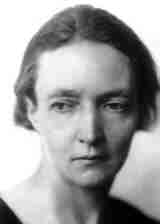 SKC Films Library |
| SKC Films Library >> Science >> Physics >> Biography |
| Irène Joliot-Curie co-discoverer of neutrons and nuclear fission
Irène Curie was born in Paris, France, on September 12, 1897. The daughter of Pierre and Marie Curie, she spent two years at a special school organized by her mother that emphasized the study of science. She then attended the Faculty of Science at the Sorbonne, but her studies were interrupted by the First World War. During World War I, Irène and her mother ran mobile X-ray machines which traveled from camp to camp diagnosing soldiers' wounds. After the war she became her mother's assistant at the Radium Institute. She earned her Bachelors from Sévigné in 1914, and her Ph.D. from Sorbonne in 1925. It was at the Radium Institute that Irène met Frédéric Joliot, a recent graduate of the Paris Institute for Industrial Physics and Chemistry who had been recruited by the Curies. The couple married in 1926, from which time their careers were joined. In 1932 the couple noted an unusual result of an experiment they had performed, but failed to understand it completely. The result ultimately led to discovery of the neutron by James Chadwick. In 1933 they investigated the formation of electrons and positrons by the passage of high-energy radiation through matter, and successfully determined the conditions under which such formations could occur. In 1934 they worked on the bombardments of various elements by alpha rays, and demonstrated that such a bombardment of boron created a radioactive isotope of nitrogen. This discovery led to the production of artificial radioactive elements, which in turn became important tools in biomedical research and the treatment of cancer, and to the couple sharing the Nobel Prize for Chemistry in 1935. Their 1938 research on how heavy elements were affected by the actions of neutrons ultimately led to the discovery of nuclear fission. Both Irène and Frédéric were active participants in the French Resistance after the German occupation of France in World War II. The Nazis initially requisitioned all of her equipment, but then placed it at her disposal, allowing her to continue her work. After the war the couple took part in the creation of the French Atomic Energy Commission, which put an atomic pile into operation in 1948. Irène was also involved in the inauguration of the large center for nuclear physics at Orsay, for which she personally worked out the plans; her work was continued by Frédéric after her death. Other positions in which Irène served include: lecturer and the Professor in the Faculty of Science at Sorbonne, 1932-1956, Undersecretary of State for Scientific Research in Léon Blum's Popular Front Government (4 months of 1936), director of the Radium Institute (1946-1956), and director of the French Atomic Energy Commission (1946-1950). She was also a member of Comité National de l'Union des Femmes Françaises, which worked for women's suffrage in France, and of the World Peace Council. Irène Joliot-Curie died of leukemia, the same disease that killed her mother, on March 17, 1956. PRINT SOURCE WEB SOURCES SEE ALSO |
| SKC Films Library
>> Science >> Physics >> Biography This page was last updated on 02/27/2018. |
